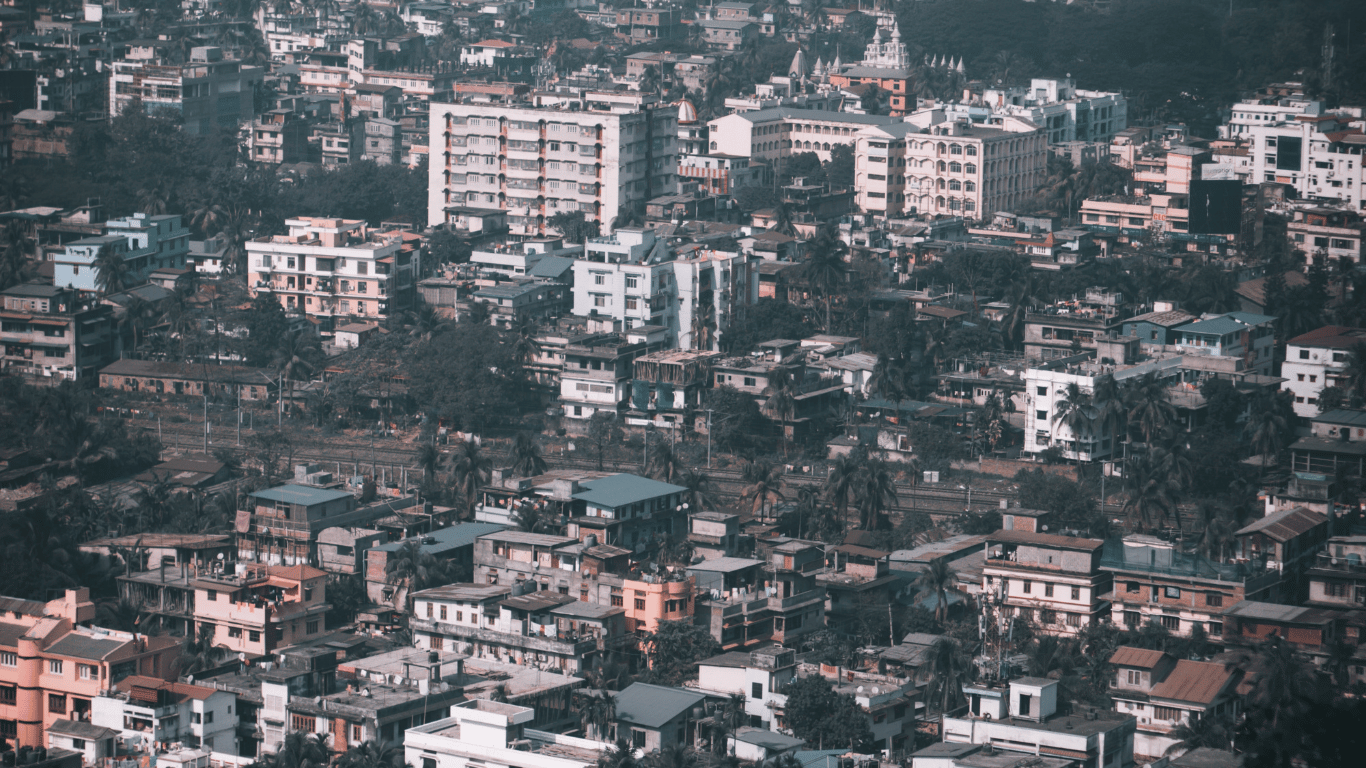
Beyond its own allure, Guwahati is surrounded by some of the most captivating and scenic destinations in the North-East. These pristine locales, perfect for a weekend getaway, remain largely untouched, adding an extra layer of allure to the prospect of a holiday near Guwahati. Furthermore, the region boasts historically significant sites and culturally vibrant locations, ensuring there are ample reasons to stay engaged and intrigued, even on a brief weekend retreat.
1. Shillong- 98 Km
Hailed as the ‘Scotland of the East,’ Shillong weaves together enchanting landscapes, delightful weather, and a tapestry of rich traditions. It is home to diverse tribal communities.Umiam Lake, a vast reservoir enveloped by hills, stands as a prominent attraction offering a peaceful retreat. The serene Elephant Falls, gracefully cascading amidst lush greenery, enhances Shillong’s natural allure. The Laitlum Canyons unfold breathtaking panoramic views, making it a must-visit haven for trekking enthusiasts.
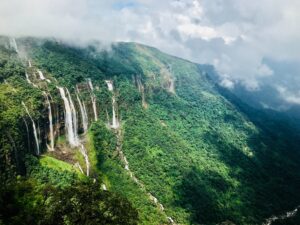
The Don Bosco Museum, a showcase of Northeastern indigenous cultures, and the Meghalaya State Museum, a treasure trove of heritage artifacts and exhibits, add depth to the city’s cultural narrative. The bustling Police Bazar, a vibrant market, pulsates with Shillong’s lively atmosphere and offers diverse shopping experiences. Beyond the city’s confines, Mawphlang epitomizes Meghalaya’s cultural legacy, renowned for its sacred groves and traditional rituals. Conversely, Mawlynnong, acclaimed as the cleanest village in Asia, beckons with its living root bridges and pristine landscapes. Shillong’s rhythmic heartbeat resonates through its title as the “music capital of India.” The city’s fusion of westernized culture and youthful spirit contributes to a dynamic music scene. Best time to visit is between September- May.
2. Kaziranga National Park- 224 Km
Nestled in the heart of North-Eastern India, Kaziranga National Park stands as a testament to India’s rich biodiversity, boasting the largest population of one-horned rhinos on the planet. Its expansive territory spans the districts of Nagaon, Golaghat, and Karbi Anglong, strategically placing it at the geographical center of the state. Approximately a five-hour road journey from Guwahati, this national treasure earned UNESCO World Heritage Site status in 1985.
Embraced by the floodplains of the mighty Brahmaputra River, Kaziranga is adorned with lush vegetation covering its vast expanse. With an annual deluge of rainfall, sometimes reaching perilous levels, the park showcases tall elephant grass, marshlands, and towering tropical broadleaf forests. Its diverse ecosystem hosts a myriad of fauna, including the iconic one-horned rhino, Asiatic elephants, wild water buffalo, and the majestic Royal Bengal Tigers. Officially designated as a Tiger reserve, Kaziranga is renowned for harbouring one of the world’s largest tiger populations. It serves as a favoured migratory destination for birds flying down from the north. Visitors can marvel at species such as the black-nested stork, lesser white-fronted goose, ferruginous duck, and Baer’s pochard duck, among others. The great Indian hornbill and wreathed hornbill, along with various bird families, further enrich the avian panorama.
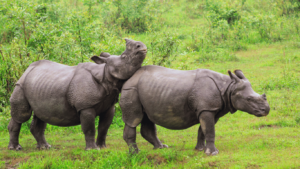
Safari experiences, available both day and night during the open tourist season, provide an immersive exploration of Kaziranga’s diverse landscapes. Elephant rides, a popular choice among tourists, offer a unique perspective on the park’s inhabitants. The best time to visit Kaziranga is between October- June.
3. Cherrapunji- 145 Km
Cherrapunji, also known as Sohra, nestled in Meghalaya, captivates with its iconic double-decker living root bridge. Situated approximately 50 kilometers from Shillong, this sub-divisional town is renowned for its natural wonders. While Mawsynram has claimed the title of the wettest place on earth, Cherrapunji boasts the record for the highest recorded rainfall in a calendar year. Beyond the famed living root bridge, the region beckons with other natural marvels like Mawsmai Caves, Krem Phyllut, Nohkalikai Waterfalls. Mawylyngnong, recognized as Asia’s cleanest village, stands as another prominent attraction, offering visitors an immersive experience in the village’s culinary delights.
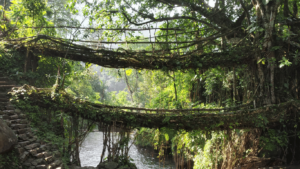
Embarking on a road trip through Cherrapunji unveils mist-shrouded valleys and cascading waterfalls, providing an ideal journey for those who are into road trip. For those who got a bit more time, the town of Dawki, bordering Bangladesh, invites exploration with its clearwater boating experience during winter. The best time to visit is between September to May.
4. Bhalukpong- 233 Km
Beyond its status as a haven for nature enthusiasts, Bhalukpong unfolds as a holistic destination, offering a rich tapestry of wildlife and an array of adventure activities that harmonize with its pristine surroundings.
Enhancing the town’s allure is the meandering Kameng River, weaving through the surrounding forest and adding to its natural charm. Bhalukpong invites travellers to immerse yourself in a spectrum of experiences, from hikes, treks, water rafting to the tranquility of camping and fishing. For a wildlife encounter, venture into the Pakhui Wildlife Sanctuary, where exotic birds share the stage with tigers, elephants, barking deer, and more. The Sessa Orchid Sanctuary or The Tipi Orchidarium, as it is commonly referred to, showcases a myriad of orchid varieties, each boasting distinct hues and sizes that never fail to captivate visitors. This reserve boasts an impressive collection of over 2600 cultivated orchids, contributing to the diverse and captivating essence of this scenic locale. Best time to visit is between October to March.
5. Hajo- 24 Km
As an age-old pilgrimage hub, Hajo stands out for its inclusive appeal, drawing devotees from three distinct religions: Hinduism, Islam, and Buddhism. The sacred landscape is adorned with shrines venerating deities such as Durga, Shiva, Vishnu, Buddha, and revered Muslim saints. This diversity makes Hajo a significant pilgrimage destination, harmoniously uniting followers from Hindu, Muslim, and Buddhist communities. Among its notable landmarks, the Hayagriva Madhava Mandir holds prominence, attracting Buddhists who believe it to be the hallowed site where Buddha attained Nirvana. The Powa Mecca Mosque enjoys popularity among Muslims. The best time to visit is between July- March.
6. Kohima- 355 Km
Perched atop the hills, Kohima, the charming capital of Nagaland, unfolds its mesmerizing panorama, preserving tales of ancient folklore. Nestled at an elevation of 1500 meters, this city captivates with its serene hills, verdant forests, and picturesque landscapes.
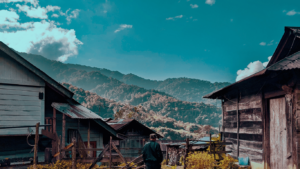
A creation of the British, Kohima is a cultural tapestry woven by the Naga and Kulkis tribes, showcasing their independence and a vibrant, mystical heritage. Must-see attractions are the Commonwealth War Cemetery, a resting place for thousands of World War II soldiers. Beyond this, the city unfolds a rich tapestry for visitors, featuring a museum, zoo, sanctuary, Shilloi Lake, Dzukou Valley & Japfu Peak, autonomous villages, and more, inviting exploration into its diverse offerings. The best time to visit Kohima is between October- June.
7. Sela Pass- 374 Km
Sela pass, serving as the vital link connecting the Tawang district to the rest of the country, is a mesmerizing gift of nature to the North-East.
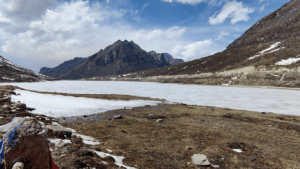
Beyond its geographical significance, Sela Pass boasts stunning vistas, perpetually adorned in snow, providing awe-inspiring views of the eastern Himalayan range. This rocky pass is graced by one of Arunachal’s most exquisite lakes – the Sela Lake. Accessible with an inner line permit due to its sensitive location, Sela Pass, and the elevated Sela Lake at 4170 meters, act as a gateway, offering a glimpse of the treasures that await within the enchanting state of Arunachal Pradesh. Standing at Sela Pass, beholding the frozen splendor of Sela Lake, one cannot help but marvel at the Himalayas’ awe-inspiring wonder.
8. Majuli- 334 Km
Majuli unfolds as a verdant, eco-friendly haven—a pristine, pollution-free freshwater island cradled in the embrace of the mighty Brahmaputra River. Spanning a vast expanse of 1250 sq. km, Majuli proudly holds the title of being the world’s largest river island, drawing admirers from across the globe. This enchanting locale stands as a strong contender for UNESCO’s prestigious World Heritage Sites.
Primarily inhabited by tribal communities, Majuli boasts a culture that is both unique and fascinating, earning it the moniker of the cultural capital of Assam. The island’s allure is further heightened by its main festival, Raas, a spectacle that captivates onlookers. Among the notable sites that add to Majuli’s charm are Kamalabari Satra, Dakhinpat Satra, Garmur, Tengapania, and more. Best time to visit is between July-March.
9. Bomdila- 345 Km
Beyond the breathtaking landscapes that grace the surroundings, creating a visual feast for the eyes, Bomdila envelops visitors in a refreshing breeze and delightful climate. The region boasts a myriad of attractions, including temples and wildlife sanctuaries, providing a harmonious blend of cultural and natural wonders. Temples, both Buddhist and Hindu, adorn the area. Noteworthy places to explore in Bomdila include apple orchards, the serene Bomdila Monastery, the Bomdila Viewpoint, the Eagle Nest Wildlife Sanctuary, and the Upper and Lower Gompas. Visitors can also immerse themselves in the local art and crafts, unique to the region, or embark on invigorating trekking and hiking adventures, complemented by the diverse and rugged terrain. Best time to explore Bomdila falls between April- October.
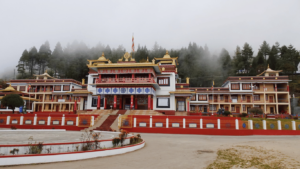
10. Siliguri- 473 Km
Siliguri, renowned as the Gateway to North-East India, has evolved into a prominent commercial and connectivity hub, gaining recognition for its tea and timber industries.
A major draw in Siliguri is the Jaldapara National Park, nestled along the banks of the Torsa River. This park boasts a significant population of Royal Bengal Tigers, elephants, one-horned rhinoceros, and diverse deer species. Opting for an elephant ride provides a unique opportunity to observe these animals up close and personal. The North Bengal Wild Animals Park is another compelling wildlife destination. Showcasing a rich array of flora and fauna, this park offers a captivating experience. Siliguri’s attractions also include the Salugara Monastery, Iskcon Temple, Coronation Bridge, Chilapata forest, and Dudhia. You can visit Siliguri any time.
A short distance from Siliguri, Mirik beckons travelers with its scenic beauty, the pristine Sumendu Lake, and a tranquil monastery. Sumendu Lake, surrounded by hills on all sides, provides opportunities for fishing and boat rides, offering a mesmerizing perspective of the picturesque landscape.
©Famous India Blog. All rights reserved.
Creativity By Needinfotech